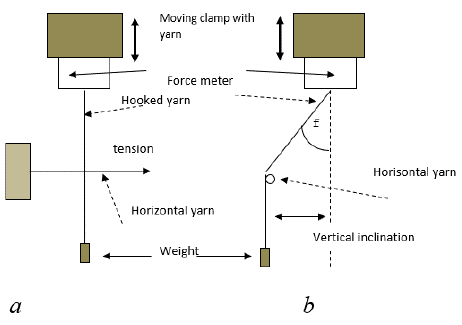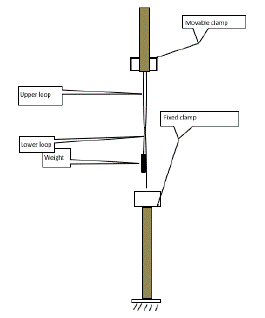
Special Article: Composite Materials
Adv Res Text Eng. 2024; 9(3): 1102.
Friction of Aramid Fibers and Method to Study It
Kotomin SV1,2*
¹Bauman Moscow State Technical University, Russia
²AV Topchiev Institute of Petrochemical Synthesis, Russia
*Corresponding author: Kotomin SV, Bauman Moscow State Technical University & AV Topchiev Institute of Petrochemical Synthesis, RAS, Moscow, 119991, Russia. Email: servk@bmstu.ru
Received: September 20, 2024 Accepted: October 10, 2024 Published: October 17, 2024
Abstract
A method for determining the coefficient of friction of aramid yarns in the “yarn on yarn” friction mode proposed, which is important for textile processing and the development of fibrous structures used in ballistic protection products. The test sample is a yarn passing through a loop, which allows calculating the coefficient of friction using the Euler– Eytelwein formula when testing on traditional stretching machines without additional devices. The friction of various types of yarns and yarns in dry and wet states is studied. When the yarns moistened, a significant increase in the friction coefficient observed. Aramid yarns with a crystalline structure (Kevlar, Armalon) have a higher coefficient of friction compared to fibers with an amorphous structure (Rusar). The presented material is useful for specialists involved in testing aramid yarns and creating ballistic protection based on them. Keywords: friction, aramid fibers, ballistic protection
Introduction
Friction plays a significant role in the processing of textile yarns into fibrous and composite materials, as well as in the properties of products made from them. Particular attention attracted to the friction between high-strength aramid yarns in ballistic materials such as bulletproof vests, where the impact energy largely absorbed by friction between the yarns. For these materials, it is essential to have an optimal coefficient of friction at which maximum energy dissipation achieves during frictional interaction of the yarns and their subsequent break. If the friction force is too high, the yarns may break before the energy dissipated by friction. If the friction is insufficient, the yarns remain in the fabric structure and move, reducing the efficiency of energy absorption [1-4]. The aim of this study is to develop a simple method for measuring the coefficient of friction and to investigate the frictional characteristics of different types of aramid fibers. A number of works have been devoted to the study of fiber friction [3,4]. The most simple and common method to study the fibers friction in a fabric is determination of the pulling force of a yarn from a fabric using a tensile machine. However, it is difficult to determine the actual friction coefficient of the yarn by this method, since the pulling force of the yarns depends on the structure of the fabric and changes during testing due to a decrease in the friction area of the yarn when pulled.
The current experimental methods for measuring the friction coefficient of a yarn are complex. For example, in accordance with ASTM D3412 standards, it is necessary to twist a continuous yarn on specialized equipment. A scheme of a simpler "connected yarn" method shown in Fig. 1, where the friction force between two crossed yarns measured (both horizontally and vertically). To calculate the friction coefficient, it is important to consider the normal force at a given point, as well as the angle of deviation f from the vertical position of the yarn on which the load is suspended.
According to the method described in [1], the friction coefficient μ was determined for Kevlar-49 fibers. The coefficient varies between 0.22 and 0.36 depending on the normal load. However, this method has a disadvantage: it requires fixing the horizontal yarn under tension and calculating the normal force at the contact point based on geometric parameters of the yarn's location. These parameters are not stable, as it is difficult to maintain the horizontal position of the yarn while under tension.
New Test Procedure
We propose a simpler technique based on the direct determination of the coefficient of friction during the friction of a yarn in a loop according to the Euler formula for the friction of a yarn along a cylindrical surface [6].
The calculation of the friction coefficient of the yarn μ is carried out by the value of its tension force before (F1) and after (F2) the friction zone, taking into account the angle of coverage of the cylinder 0: (1)

Figure 1: Scheme of the “suspended yarn” friction test: (a) front view (b) side view.
![]() (1)
(1)
When the clamp moves in one direction, the vectors of the weight of the load and the friction force added, and when moving in the opposite direction, they subtracted. The force F received by the force meter when the test machine is clamped up and down is related to the weight of the load P and the friction force F fr as follows:
![]() (2)
(2)
The contribution of the friction force and, accordingly, its sign determined by the direction of movement. The angle of coverage of the yarn with the yarn in the friction zone takes as p. When the load is moving upwards, the calculation formula (1) takes into account the equality (2) takes the form
![]() (3)
(3)
and when moving downwards —
![]() (4)
(4)
A piece of yarn, about 10-15 centimeters long, fixed in the movable clamp of the tensile testing machine, forming a loop. Then a second piece of the same yarn passes through the loop and fixed at one end on the fixed clamp. Finally, a loading weight is attached to the free end of the movable piece, as shown in Figure 2.

Figure 2: Scheme of the test.
Speed of the clamp movement on the tensile machine (Instron-1122) during the test was 10 mm/min. Weight loading the yarn - 1 N. The force of normal pressure on the yarn at the contact cross point, respectively, reached 2 N, but this parameter is not included in equation (3) for calculating the friction force.
Objects to Study
The friction of aramid fibers Rusar, Kevlar, Armalon, Newstar, and Heracron (without sizing) with different linear densities studied. The data available in the literature on the friction of Rusar yarns indicate a significant influence of the sizing on the coefficient of friction, which varies depending on the type of sizing in the range 0.25...0.35 [7].
Rusar fiber is a copolymer of poly para-amidobenzimidazole terephthalamide and poly-para-phenylene terephthalamide, produced by JSC Kamenskvolokno in Russia. Kevlar 29 is a fiber based on poly-para-phenylene-terephthalamide manufactured by DuPont (USA), and its analogues include Heracron fibers produced by KOLON Industries (South Korea) and Armalon produced by Tema-M JSC in Mytishchi, Russia [8]. All these types of fibers applied in the production of body ptotection. For comparison, we also used 3 another types of heat resistant fibers: Newstart (Yantai Tayho Advanced Materials Co, Ltd, China) which is analog of NOMEX from poly – m-phenylene terephtalamide, Arselon from polyphenylene oxadizole (Svetlogorskkhimvolokno OJSC in Belarus) and a polyacrylonitrile PAN ( d by NITRON JSC in Russia. The fibers were studied both in their "dry" state, with an equilibrium moisture content corresponding to the ambient humidity, and after being moistened by short-term immersion in water (followed by removing excess moisture using filter paper).
Results and Discussion
For Kevlar, the value of the friction coefficient turned out to be quite close to the values determined in other works, which allows us to consider the results obtained by this method quite correct. Aramid fibers Kevlar, Heracron and Armalon have similar values of the coefficient of friction μ, exceeding 1.5 times its values for the Rusar fiber (table 1). A possible explanation for this difference is the high crystallinity of PFTA fibers, unlike which Rusar fibers characterized by an amorphous structure of the fiber-forming polymer [9]. Although, when interacting with the matrix in composites, the amorphous fiber structure promotes the diffusion of the binder and, as a result, increases adhesion. With "dry" friction, the coefficient of friction is higher at the crystalline surface of aramid fibers. The methodology under examination enables us to quantify the coefficient of friction between a pair of distinct filaments. The results obtained for the combination of Rusar and Kevlar indicate a high level of friction between these yarns (within the limits of measurement error). It is evident that, if required, the degree of frictional engagement of the filaments can be adjusted by varying the composition of threads in composite fabrics.
fiber (in pair)
typeRaw Density,
TexFriction coefficient*
dry
wet
PAN
190
0,38
0,53
Kevlar
160
0,41
0,53
NewStar
80
0,27
0,32
Rusar
17
0,25
-
Rusar
60
0,28
0,31
Arselon
100
0,33
0,39
Armalon
8
0,34
-
Heracron
Kevlar/Rusar167
160/600,44
0,49-
Table 1: Friction coefficients of yarns*.
• Dispersion 10-15%
The data also show that the friction of the yarns increases significantly after wetting, by almost 1.5 times. This may be explained by an increase in the cohesive interaction between the yarns on the surface. This phenomenon was noted earlier when assessing the friction force that occurs when pulling a yarn from a wet fabric [10]. The thickness of the yarn plays a significant role in the tests, which can be associated with the specific pressure in the contact zone, which decreases for thicker yarns at a constant load weight. Euler's formula is applicable to flexible yarns, but aramid fibers have rather high rigidity. Therefore, the proposed method is most convenient for studying the friction of similar fibers with close linear densities, for example, to assess the effects of finishing and surface treatment.
Conclusions
A simple method for determining the coefficient of friction of yarns in a loop using a standard tensile testing machine proposed. The study showed a higher coefficient of friction for aramid yarns with a crystalline structure compared to yarns made of an amorphous polymer. Wetted yarns have a lower coefficient of friction.
References
- Briscoe BJ, Motamedi F. The ballistic impact characteristics of aramid fibres: the influence of interface friction. Wear. 1998; 158: 229–247.
- Kirkwood KM, Kirkwood JE, Lee YS, Egres RG, Wetzel ED. Wagner Yarn Pull-Out as a Mechanism for Dissipation of Ballistic Impact Energy in Kevlar® KM-2 Fabric, Part I: Quasistatic Characterization of Yarn Pull-Out N.J. Textile Research Journal. 2004; 74: 920–928.
- Bazhenov SL. On the role of friction in energy dissipation upon transverse ballistic impact on fabric. Polym Sci Ser B. 2006; 48: 282-286.
- Bazhenov SL, Goncharuk GP. A study of yarn friction in aramid fabrics. Polym Sci Ser A. 2012; 54: 803–808.
- Gupta BS, Ajayi JO. Kutsenko M. Friction in textile materials. Cambridge, Woodhead Publ. 2008: 174–218.
- Lenzing instruments. Available at: https://lenzing-instruments.com/wp-content/uploads/2019/06/μ-Meter.pdf.
- Mikhailova MP, Tkacheva LV, Slugin IV, Kashirin AI, Sklyarova GB. Work clothes and personal protective equipment. 2009; 5: 20–22.
- RU Patent № 2111978
- Kotomin SV, Milkova LP, Tokarev AV. Polymer science. Series A. 1997; 39: 446-451.
- Bazhenov SL, Goncharuk GP. The influence of water on the friction forces of fibers in aramid fabrics. Polym Sci Ser A. 2014; 56: 184–195.